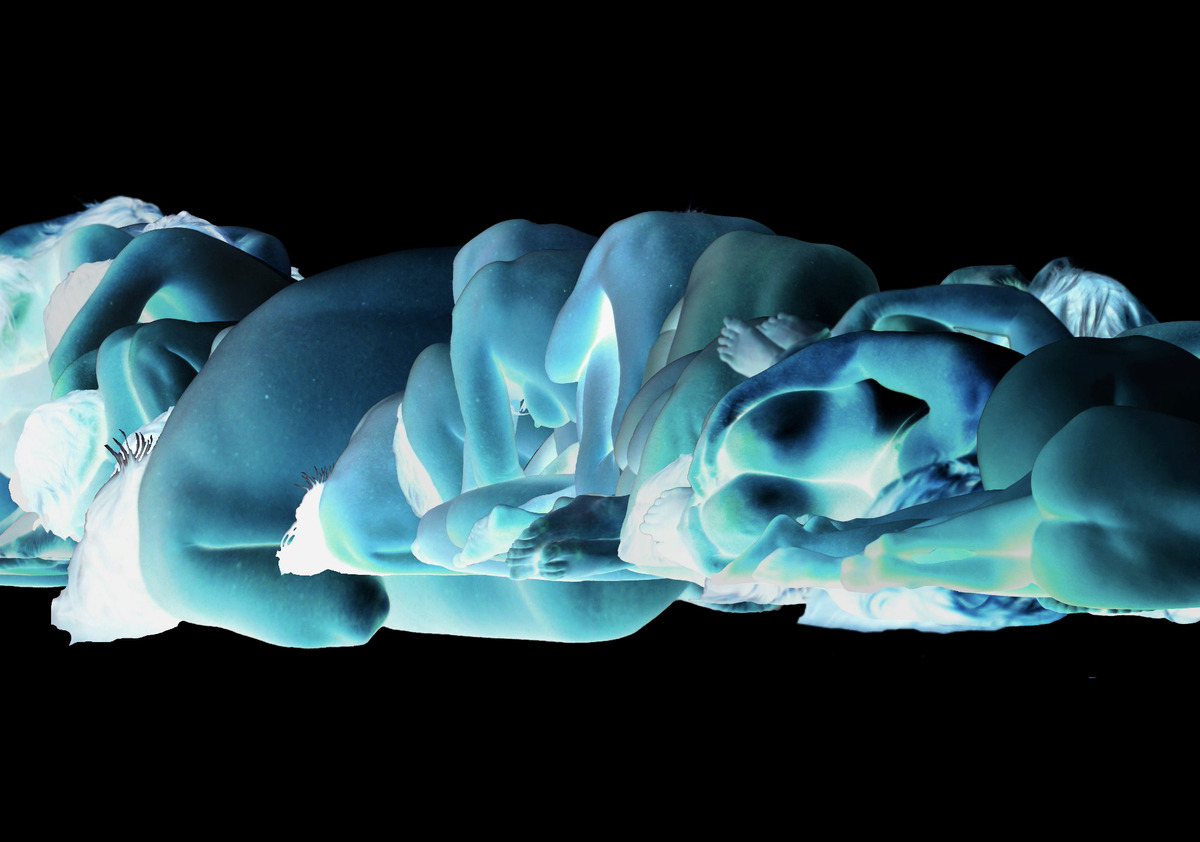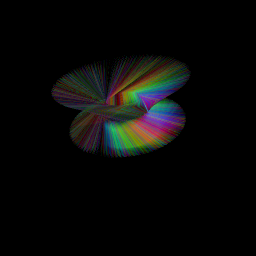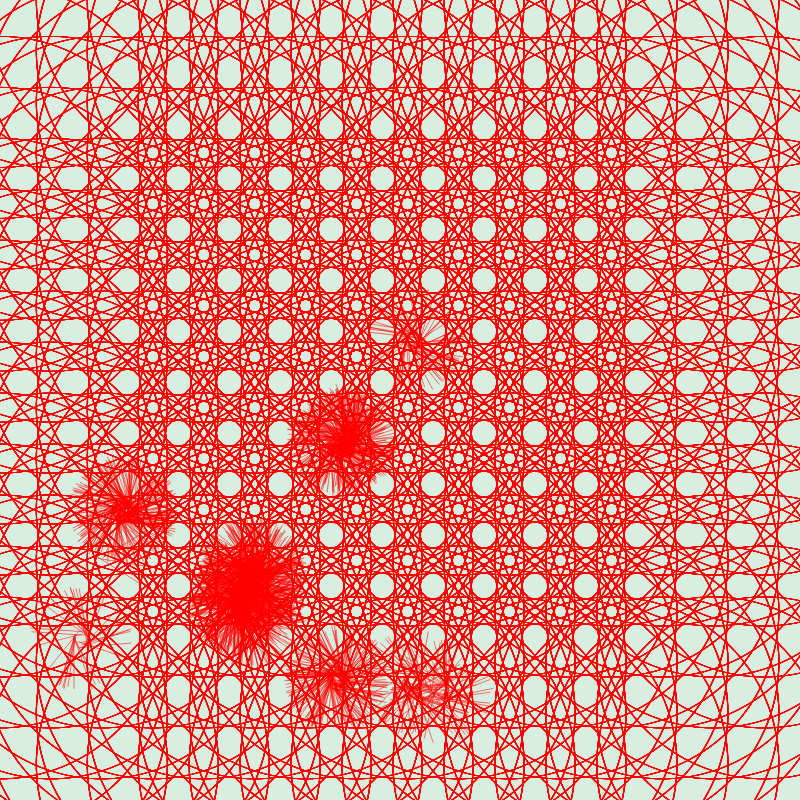
Representing Bodies in Generative Art: A Conversation with cari ann shim sham*
written by fx(press)
For our audience who isn’t already familiar with you. can you give us a little background about yourself?
I am a wild artist working at the intersection of dance & technology.
My practice explores bodily circular movements' relationship to magic, human interactions with technology, the power of asking questions and the possibilities of improvisation and experimentation to liberate dance. I often work in the nude.
I am the co-founder and curator of the Museum of Wild and Newfangled Art, an online digital art museum with joey zaza, launched in 2020 to pay artists and create a sustainable business model for the arts. MOWNA has presented nine exhibitions, including two biennials, developed an AI curator for the MOWNA exhibit This Show is Curated by a Machine and recently had the honor to curate for objkt.one, a collection of curated 1/1 artworks by artists from across the globe and part of objkt, the largest digital art and collectible marketplace on the Tezos blockchain. Our upcoming exhibition, Exit Plan, asks artists to think about how to use the blockchain in lieu of Web2.
I am currently investigating blockchain GIF archival of performance on Tezos, developing an AI choreographer, and ways of using blockchain in lieu of social media. In my free time, I enjoy free diving with dolphins, dancing underwater, going to contact improv jams, and hunting wild edible mushrooms.
My students, too, are always surprising me and themselves with the code that they create. This brings me joy. - cari ann shim sham*
What motivates you to continue exploring generative art? How often are you surprised by your code and its creative possibilities? Is there anything you feel is entirely unique to your approach to generative art?
Generative art is liberating to me as it makes the impossible possible. I love how I can create now with code the effects that I have long applied to images or videos via software.
I am always drawn back to generative art with every project I work on, as it is the code that allows me agility as an artist working digitally. The code always surprises me. My students, too, are always surprising me and themselves with the code that they create. This brings me joy.
My approach to generative art is unique in how I am coming from a performative bodily practice which includes the filming and photographing of the body, and from a place of ritual bodily practices that create sacred space and magic.
auras (scotomas from an auric migraine) #5

Can you elaborate on the concept behind your fxhash 2.0 release, body landscapes? Can you walk us through some aspects of the technical and creative processes used for this work?
Creative ideas come to me in flashes, visions, and dreams. A little over a month ago, I dreamed of five bodies in a white, vacuous light strip. Each body morphed between two positions. Tiny movements with trails: a head, a hand, a foot. The bodies were mine. And it felt good to gaze at them. It felt as though I was at my own exhibition.
Shortly thereafter, I received notification that Carla Gannis curated me for the Loop Art Critique and Exhibition, which spans a month with eight critique sessions culminating in a show exhibited in the Loop metaverse. The perfect opportunity to develop the image from my dream, body landscapes. The show opened on December 15th. You can find my exhibit body landscapes GIFs here. The body landscapes GIFs collection is also available on objkt here.
The work begins with my body. As a dancer, my body acts as a conduit for messages. It writes, it gestures, it speaks. Beyond language, dance communicates. My body has things to say, through shapes and shudders, through bends and folds.
To prepare, I warmed and stretched my body with yoga, followed by meditation, to get in touch with my internal state. I then pulled out my Lumix GH2 camera and used my favorite lens setup, a c-mount 25mm tv lens. Using a 10-second timer, a mix of NYC sunlight and tungsten light, I began photographing my body in different shapes within a restricted space. The frame was my box, the monitor screen was a cage, and the body fit inside the box.
Rule 1 - fit in frame.
Rule 2 - cover face.
It was part of my emotional state to cover my face, to hide that part of me from the self-portrait, to be non-confrontational when confronting myself. To not see my seer.
Rule 3 - relax.
Once I found a shape, I would breathe in and let my body relax, release, and drop into the shape. Belly loose, bones connecting into the floor, muscles melting, the body released. This is not a pose. This is a shape, a feeling, a state. This is a body landscape.
Crawling back and forth to the camera and back to my spot over 100 times, my knees bruised, and my body grew tired. I stopped the capture and began the edit with Adobe Photoshop. As photos were selected, backgrounds removed, brightness, levels, curves, and hue adjusted, and images resized to 720 for a smaller data footprint, I began to see the dream.
To further visualize, I brought the photos into Adobe Premiere to animate them into GIFs. Not getting the result I was after I turned to code. I began by working with five images, trying to make them switch back and forth between each other. Then, I found that I could animate them to get the motion blur and emotional state heightened by jiggling the images randomly. I added all 43 selected images to create a full body landscape that moved across the screen from right to left in the sequence where the photos were taken.
As a dancer, my body acts as a conduit for messages. It writes, it gestures, it speaks. Beyond language, dance communicates. My body has things to say, through shapes and shudders, through bends and folds. - cari ann shim sham*
I then explored randomizing the numbers of bodies, the order of the sequence of bodies, and the scale of the bodies. Next, I added filters and backgrounds to enhance the color field and emotional quality. Once satisfied, I tested and discovered a rare occurrence of a black or white box appearing occasionally.
To me, this represents that box that I was trying to fit into, the restriction of the frame, the screen as a stage. The magic box. Rule #1. It is the rarest version.
Having my picture taken is something I do not enjoy. As someone who is usually behind the camera, it's become important to interrogate myself with my camera through self-portraiture. I began in 2017 with my Green Tara goddess self-portrait project using Green Tara meditations to create eight self-portraits for the eight great fears.
A Green Tara goddess meditation on the carnivorous demons of doubt. Fear of flesh-eating demons, suffering through doubt. The sixth of the eight great fears.
Usually, the form of Green Tara, also known as Tara of the Khadira Forest, is the main deity that is considered to give protection from the eight great fears. But there are also individual forms of Tara for each of the eight fears as well.
The eight fears are considered to have an outer aspect, such as lions, elephants, etc., and an inner aspect, the mental defilements they represent. While the outer fears, or dangers, threaten our lives or property, the inner ones endanger us spiritually by obstructing or turning us away from the path to enlightenment.
In 2020, I was diagnosed with breast cancer on March 15th, the day the city went into lockdown. Cancer during the pandemic was an extreme layer of emotions and suffering that I am still processing. My body is my instrument and has gone through a major transition: surgery, radiation, nerve damage, cording, weight gain, pain, range of motion restriction, physical therapy, depression, rehabilitation, and recovery.
These portraits for body landscapes are a way of making peace with my body and all that I've been through. Further, my shapes seek to capture what we've all been through. The shapes are reflective of the various feelings and emotional states that I've been moving through in these last six weeks.
The need to hold oneself, to rest, to curl, to lay, to lean, to fall, to roll, to tuck, to curve, to hug, to relax, to release…
My body is my medium, and the medium is the message.
Now I await the outputs, to see the landscapes that my body will create, to feel the emotional states that these landscapes will evoke, and to enjoy the peace and release that they bring to whoever may gaze upon them."
You can read more about the creation of body landscapes here.
...my shapes seek to capture what we've all been through. The shapes are reflective of the various feelings and emotional states that I've been moving through in these last six weeks. - cari ann shim sham*
Figurative work and body representation are still very rare in generative art. Do you see this topic as something that more artists will explore in the future?
I hope so. It is a difficult area to work in. And it is a healing area to work in which is so needed right now as we are all living in these bodies that we mostly ignore. There is so much power within each and every one of us. The power of breath, the power of movement, of stillness, of rest, of sound, of meditation, and magic. We hold all of this power in our bodies. [quote] There is much to be explored within ourselves. It is a practice to be embodied. To be present. And when we are so deep into our screens, we can lose that power.
To bring the body to generative art, you must physically work with the body from the inside out, so that is one way of slaying the dragon we are all sitting with. Literally sitting in front of tapping away at with our fingers and staring at into all hours of the day and night; the computer. An extension of our body. And yet, not the body. So how does the body extend itself into the computer? How is my body the medium for the message? That is the question I like to wrestle with.
There is so much power within each and every one of us. The power of breath, the power of movement, of stillness, of rest, of sound, of meditation, and magic. We hold all of this power in our bodies. - cari ann shim sham*
How do you see your practice evolving in the context of generative art and NFTs? What future do you envision for yourself as a generative artist?
The blockchain has completely transformed my practice. It has given me a space to put my digital things. I've toured the world as a video artist and filmmaker, and the work I've been making can only be seen for a very short window of time in an installation, or as part of a theatrical production or a film festival, then never again.
Now I have this wonderful space to have my work live. This wonderful space has made me rethink, revise, reevaluate, and restructure how I make work. Now, the work must move and be concise in content and communication, uploadable - small in size. I ask how to bring dance, performance, my body and its emotional states, experience, and magic to the blockchain.
I began working with Processing 9 years ago at ITP in 2015 when I moved to NYC to teach at NYU. In 2019, I created a course to teach dancers how to code - Creative Research: Composition for Interactions with Technology. Along the way, I made many sketches, and generative artworks for live performances, installations, and websites. It wasn't until fx(hash) came along that I considered myself a generative artist. And it was in 2022 when I had a breakthrough that dance is generative art, and I've always been working as a generative artist. I wrote an fx article about it.
This web3 moment we are in has evolved my work into always somehow working with and through the blockchain. My newest project is the development of an open-source AI choreographer biased toward inclusive and accessible movement. I trained the EmProps Stable Diffusion model to create generative AI dance prompts as phase one of a participatory artificial intelligence generative dance project to develop an AI choreographer. Many aspects of this project will live on the blockchain, and you can read more about it here.
The ability to write about my work via the blockchain, to mint an article, have that article accessible to be seen freely without a paywall or login, and for it to be collectible and even generate income is revolutionary and has inspired me to share more about my creative research.
slow draw (rare version) #2

Where do you see this medium going in the next 5, 10, or 20 years? Is institutional acceptance important to you?
I see blockchain as the future for the art market, the art world, currency and banking, real estate, identification, and many other things.
Generative art is having a really impressive moment right now, and I wonder if that will last. If generative art evolves to its full potential, I feel that it will have staying power. It would be great to have larger file sizes to be able to work with on generative art platforms so that we can do bigger work and really push the field in that way. I do love working with rules or within restrictions, and that leads to great art as well. Still, I want more space to stretch out my body when uploading my work. Also, the ability to place a project cross-chain, so that one can mint it on both Tezos and ETH, for example, would be grand.
Institutional adoption is happening, slowly. MoMA with the postcard series and acquisition of Refik Anadol's work, Whitney acquiring NFTs from notable artists such as LoVid, LACMA acquiring a collection of NFTs, all of these moments solidify the future for blockchain, web3, and artists who upload. It is also important to cite the museums that are working within web3 and how they have paved the way for these institutions to enter into the space.
Critics viewing generative art as fine art doesn't matter much to me. Generative art is fine art already. I see critics as a vehicle for drawing attention to something, whether they like it or not, they are attraced by noise, so that is somehow helpful. They don't need to like it, they just need to talk about it.
Do you collect generative art from other artists as well? What do you like, or what types of work appeal to you most?
Yes, I do have an extensive collection of work on fx(hash), objkt, and EmProps, with a smaller collection on Ethereum. When collecting, I go for the artist first, then for art that touches my soul. Further, I collect women, non-binary, and culturally diverse artists. I enjoy artwork that moves, has sound, deals with the body, makes me laugh, or uses the blockchain in lieu of social media or web2 to communicate messages. Also, work that is unique in its technique or is interactive attracts me.
How much do you think about the chain your artwork is minted on? Does it matter to you now, and do you think this will be more or less important in the future as blockchains evolve?
Yes, the chain matters to me. With the climate crisis, I keep a close eye on my carbon footprint. I travel less, am very careful with what and how I consume and I support local business and farming. With blockchains, Tezos, at the moment, is the chain where I've put most of my work as it is the greenest, second to Ethereum, as both these chains are now proof of stake and use less energy than others.
—
cari ann shim sham* is an award-winning wild artist based in New York City, working in AI, blockchain, Web3, VR & XR, generative art, generative dance and creative coding, Inflatables, Cinema, Photography, Video Art, Theater, Opera, and Dance, with several decades of experience in programming, producing, and directing film, music, and dance festivals. She is a Full Arts Professor of Dance and Technology at NYU, TISCH School of the Arts.
Her web3 work has been exhibited with Li Tang Gallery, NFT Bali via Superlative Gallery, Las Lagunas Art, and Loop Art Critique. Previously, she collaborated with fxhash as a curator and moderator for the fx(fam) event, putting together a panel on women and non-binary artists and for the Antidote Festival fx(hash) Art Talks with Wanda Oliver.
body landscapes will be exhibited at the Loop Art Critique exhibition, between December 15, 2023 and February 2024.
body landscapes will be released on fxhash on December 22.